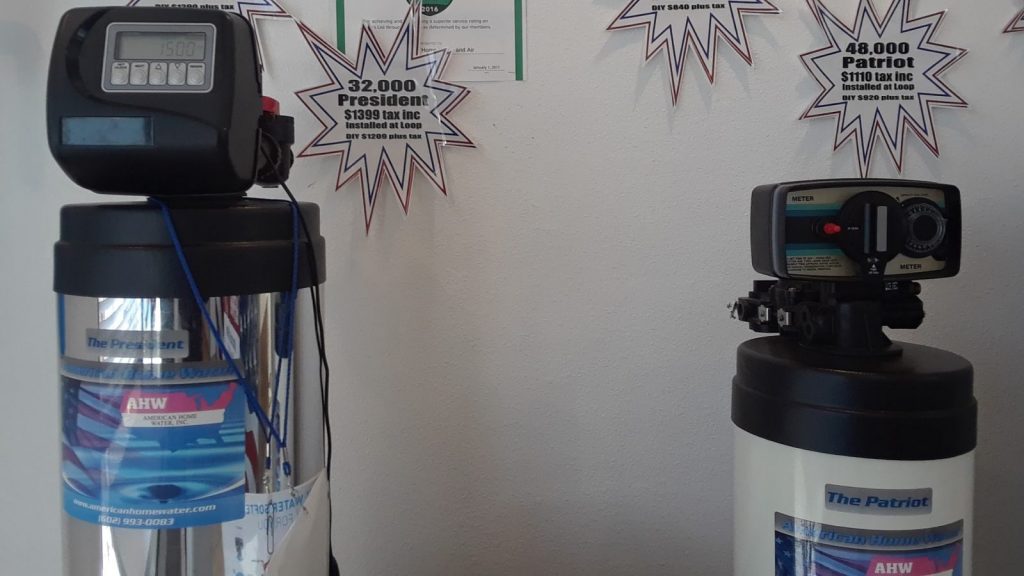What does a water softener remove? Can it replace a whole house filtration system? These are among the most common questions we hear at American Home Water and Air. Read on to better understand exactly what water softeners do and where they fit into your home filtration setup.
What Does A Water Softener Remove?
A water softener removes the minerals (most significantly calcium and magnesium) that make your water hard in the first place. To do this, these systems most commonly use an ion exchange process that replaces the calcium and magnesium ions for sodium or potassium ones. This process relies on resin beads that retain the mineral ions and then replace them with sodium or potassium that originates from pellets in a separate tank.
It’s important to note how this process works, particularly that it lacks the membranes typical of most water filters. You see, while water softeners technically do filter out minerals, they are not what experts are typically referring to when they discuss water filters. This is because standalone water softeners are only designed for removing minerals from water. They do not get rid of heavy metals or chemicals like chlorine.
Water softeners are not just less-efficient filters, though; they fulfill a very necessary function that typical filters cannot. More on this shortly.
How Else Can You Remove Minerals from Water?
The ion exchange method is currently the most efficient for removing minerals from water on a residential scale. Homes all across cities like Phoenix, Arizona use ion-exchange water softeners for this reason. While 85% of the water in America is hard, the state of Arizona is one of the most affected regions of the country. To make a long story short, it’s all because of our state’s geology.
Reverse osmosis filters do typically remove some minerals from your water but the effect is minimal compared to what you can achieve with a softener. In fact, without a softener, the minerals will actually damage your reverse osmosis membrane and make it less efficient.
Potassium Chloride vs. Sodium Chloride
When it comes to the ion exchange method, you have two options: sodium chloride or potassium chloride. At American Home Water and Air, we recommend the former as it is the most effective. Systems that use potassium chloride don’t produce truly soft water; they simply prevent minerals from forming scale while leaving them in the water. They do not remove the minerals from water and are instead called “water conditioners.”
Potassium may be suitable, however, for people required to maintain very strict control over their sodium intake. Barring such health concerns, a water softener that uses sodium pellets should not have negative impacts at all.
Beware Phony Contraptions Promising to Remove Minerals from Water
Now that you know how to remove minerals from tap water, it’s worth spending some time discussing the phony contraptions that promise to achieve the same results using dubious technology.
The manufacturers of such contraptions (which usually involve magnets) try to convince uninformed buyers that sodium-based softeners will damage their health. In reality, this sodium’s effect on your water is negligible; you get more salt from a slice of bread.
How To Remove Minerals From Water: Where Do These Systems Fit In The Filtration Chain?
By now, you should understand how to remove minerals from tap water; by using an ion exchange-based water softener. You should also understand that removing minerals is all standalone water softeners are really designed to do.
So does that make them unnecessary? Would you be better off simply buying a whole house filtration system instead?
No!
Water softening and water filtration are both necessary for providing your family clean, safe drinking water. Most standalone filters do not soften your water, and vice versa.
There are some all-in-one systems (like our Scale Control Water Treatment System) that contain the necessary equipment for both processes. However, you can also use both systems in conjunction to both filter and soften your water. The exact setup for doing that will depend on your home and water needs. If you’re in the Phoenix, Arizona area, give us a call and we’d be happy to help.
How To Remove Minerals From Water: Why Even Bother?
Before we wrap up, it’s worth exploring why you should even bother removing minerals from water. Here are a few of the primary reasons.
#1. Hard Water Can Damage Your Skin and Hair
The minerals in hard water have a tendency to dry out your skin and hair. Further, hard water prevents certain types of soap from lathering, making it more difficult to take a proper shower.
#2. Hard Water Also Damages Any Equipment It Touches
Hard water produces scale in your plumbing, dishwasher, water filters, and even laundry machines. This buildup prevents these systems from functioning properly. Over the long haul, it can cause significant damage.
#3. Hard Water Increases Your Bills
The prior two effects we mentioned mean you’ll need to use more water, soap, and detergent to achieve ideal levels of cleanliness. This will add up on your utility and grocery bill over time.
A water softener, while by no means cheap upfront, will reward you with significant savings over the long haul. High-quality softeners will last for 15-20 years and only require occasional servicing in the form of cleaning and refilling the brine tank.
Conclusion
By now, you should have a solid understanding of how to remove minerals from water and the limitations of this method. To recap, ion exchange-based water softeners are the only reliable way to soften water on a residential scale. Methods involving magnets are phony; avoid them at all costs.
While a water softener removes minerals, it does not get rid of other types of impurities — nor does a standalone filter soften your water. Both processes are crucial for providing your family safe, clean drinking water that doesn’t produce scale or any other plumbing issues. For this reason, we recommend using a water softener and water filter — or an all-in-one system that combines the two.










